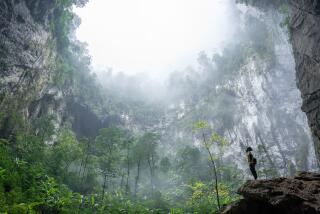Team Reaches for Bottom in Vast Mexican Cave : Exploration: Sistema Cheve could provide a record for underground discovery, but water is a big worry.
- Share via
Louise Hose and her fellow scientists want to walk, crawl, rappel and swim their way to a world record by reaching the bottom of the deepest cave ever explored in the Western Hemisphere.
Sistema Cheve--the Cave System--is the simple name of the vast underground network in southern Mexico. Exploring it hasn’t been so simple.
On future expeditions, Hose hopes to travel from the cave’s main entrance to its bottom, 8,085 feet lower. “It would surely be the greatest achievement ever made in subterranean exploration,” she says.
So far Hose, a geologist at the University of Colorado at Colorado Springs, and her colleagues have investigated to a depth of 4,574 feet in Cheve, which cuts into an area of rugged limestone mountains about 60 miles north of Oaxaca.
The current record for cave exploration belongs to a team that reached a depth of 5,286 feet in Reseau Jean-Bernard, France.
“Water is one of our biggest worries,” Hose says of Cheve. “Heavy rain on the surface can get into the cave and affect the flow of water in many places. If somehow you get trapped, there’s little time to get out of a dangerous situation.”
Probing Cheve’s depths requires the combined skills of a mountain climber, a swimmer and a contortionist. Burdened by backpacks, the explorers must climb bungalow-size boulders, rappel down waterfalls, swim across deep pools and squeeze through narrow slots.
Cave exploration has been likened to mountaineering on a moonless night. Guided only by headlamps mounted on their hard hats, cavers often have to edge their way along narrow ledges and use their rope skills to climb sheer rock faces.
Cheve already has taken one life since it was first explored by U.S. cavers Bill Farr and Carol Vesely in December, 1986. A man who may have mishandled his rope fell 75 feet to his death last year.
For Hose and other scientists, there is much more at stake than just setting dangerous records. The water that feeds into Sistema Cheve from streams and rainfall comes out at the bottom in a torrent that affects villages for miles around. The cave system has been sculpted out of the limestone by at least four streams in the area.
“It’s the deepest proven fresh-water hydrological system in the world, and we want to know more about it--everything from rock structures to flow systems,” said Hose, whose research is supported by the National Geographic Society.
“The Cheve project is not only trying to answer good scientific questions but it’s also dealing with tough engineering and exploration problems,” said John Mylroie, a Mississippi State University geology professor. “It’s like going to the moon or the deep ocean floor, but there are no technological shortcuts at Cheve. They still have to rely on muscle power.”
Few cavers return to Cheve’s surface without scratches and bruises. In some places they have to squirm, crawl and slither through openings no more than 10 inches wide.
At a feature in the cave called the Salmon Ladders, researchers have to either climb up or rappel down a series of small waterfalls before reaching the Swim Gym, a 660-foot-long passage filled with 30-foot-deep pools.
“In the Swim Gym,” Hose explains, “you’re forced to dive in and climb out of a series of pools, or else maneuver along some ropes that we’ve set up there to help climb around them.”
But Cheve’s wonders more than make up for the hardships. White calcium carbonate stalagmites 100 feet high tilt at crazy angles from the floor in a cavernous chamber known as the Hall of the Restless Giants. In deeper parts of the cave, streams have carved glistening gray-and-white marble canyons niched with small alcoves.
At Arne Saknussem’s Borehole, named after a Jules Verne character, the cavers enter a long passage 165 feet high littered with massive boulders.
Further exploration of the cave is currently stymied by the Terminal Sump, a large, water-filled chamber that drains into more tunnels leading to the bottom of the system. An adjacent side passage that may lead downward is blocked by boulders.
Hose is confident that future expeditions will figure out ways to overcome these obstacles. But for her, the thrill of discovery is more important than setting a new depth record.
“There just aren’t many places in the world,” she says, “where average individuals, backed by their own skills and minimal money, can go see totally unexplored areas.”
More to Read
Sign up for Essential California
The most important California stories and recommendations in your inbox every morning.
You may occasionally receive promotional content from the Los Angeles Times.













